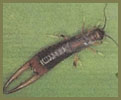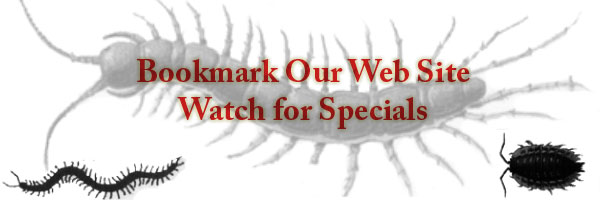Artic Pest Control Learning Center

Imported fire ants are aggressive, reddish brown to black ants that are 1/8 to 1/4 in long. They construct nests which are often visible as dome-shaped mounds of soil, sometimes as large as 3 feet across and 1 1/2 feet in height. These ants are notorious for their painful, burning sting that results in a pustule and intense itching, which may persist for 10 days. Infections may occur if pustules are broken. Some people have allergic reactions to fire ant stings that range from rashes and swelling to paralysis, or anaphylactic shock. In rare instances, severe allergic reactions cause death.

Carpenter Ants cut galleries into the wood in your home. Colonies can contain up to 50,000 workers, and infestation are very difficult to control. Carpenter ants may also be mistaken for termites.
Cockroaches

Rodents multiply so quick, just few can lead to an out of control infestation before you know it.

Spiders are not only a nuisance with their webs around the house they can also inflict painful; sometimes dangerous bites.

Silver Fish are found in areas of high humidity, silverfish eat though paper and other items with high starch content. Can be found nesting in attics, closets, under carpet ,bathrooms and kitchen area.

Fleas feed on human blood through small bites in the skin. They can jump from your carpet up to your ankles and calves, and a female flea can produce up to 800 eggs during her lifetime.

Ticks carry many serious diseases,including Lyme disease, encephalitis and typhus. They can live over 500 days with out a meal.

Wasp can be distinguished from bees by their smooth, rather than hairy, bodies. Very protective of their nests, they will defend against invaders with painful stings. The common bee sting while harmless to most people, can be very painful.

Female moths can lay up to 200 eggs, and moth larvae feed on wool fabric and fur, doing damage to valuable clothing items.

Earwigs are beetle-like, short-winged, fast moving insects about one-half to one inch in length. They have chewing-type mouth parts, a pair of pincer-like appendages at the tip of their abdomen and are dark brown in color. The female lays about 50 tiny eggs in a subterranean burrow. The eggs hatch into nymphs in about 7 days and the nymphs feed on their egg case.

Termites feed on materials that contain cellulose, primarily dead wood and wood by-products. Subterranean termites are closely associated with the soil habitat where they excavate a network of tunnels through the soil to reach water and food. These termites need moisture to survive.Each termite colony contains three forms or castes, which are the workers, soldiers, and reproductive's.
Preventive practices are a critical aspect of termite management. Avoid moisture accumulation near the foundation, which provides water needed for termite survival. Divert water away from the foundation with properly functioning downspouts, gutters, and splash blocks.Its is very important to have your home inspected every year for termites.

The white-footed ant has become a major household pest in Florida. Homeowners, pest control companies, and the news media are constantly asking university researchers and county extension offices for information on how to control these ants. This fact sheet provides information on the white-footed ant and its habits. We also describe ways to reduce white-footed ant problems in your home or building.
Like many other pests, the white-footed ant has been spread worldwide by human activities such as travel and the shipment of cargo and other materials. In Florida, transportation of infested home landscape plants and materials, and perhaps nursery stock, appears to be the most common way it is spreading.
White-footed ants don't bite or sting nor do they cause damage to structures. However, white-footed ants are a major pest because they invade homes, have huge colonies, and are difficult to get rid of. Large numbers of white-footed ants are often found outside of buildings, too. Some researchers estimate there can be eight thousand to three million ants in a colony.
Because they have such big colonies and many young to feed, large numbers of white-footed ant workers leave the nest to search for food. The inside of a home is a great place to find nest sites and food.
The white-footed ant is a 1/10 to 1/8 inch (2.5-3 mm) long, black to brownish-black ant. It is called the white-footed ant because the "foot" (which actually is the lower part of the leg known as the tarsus) is yellowish-white. The waist has only one knob-like node and each antenna has 12 segments. The white-footed ant does not have a sting.
In most typical ant species, foraging ants feed their nest mates and brood regurgitated food. This behavior is called trophallaxis. Although not known for sure, it is believed that white-footed ants do not engage in trophallaxis. Instead, foragers produce non-fertile eggs (called trophic eggs) that they feed to their nest mates.
White-footed ants nest at or above ground level. They do not nest in soil. A single colony may have nests in many locations. It is almost impossible to tell one colony from another because different colonies will be connected to each other. The white-footed ant prefers nest sites that are near moisture and food sources, and protected from predators and extreme heat. Nests tend to be found outside of structures more than inside. Indoors they nest in wall voids and attics. Occasionally, clusters of white-footed ants remaining motionless may be observed on walls. Currently, there is no explanation for this curious behavior. There is some speculation they are resting. Outdoor nests are often found in tree holes or on the underside of leaves, on bushes, under palm fronds and old leaf boots, in loose mulch, under debris such as newspaper, fallen coconuts, scrap wood, etc.
The white-footed ant is extremely difficult to control because it has such large colonies. In most cases a professional pest control company should be hired to treat infestations. An integrated approach using the following practices should provide the best results. Be aware that satisfactory control requires patience and a bit of work.
Phone: (407) 443-7612
E-mail: AdamL@articpest.com




